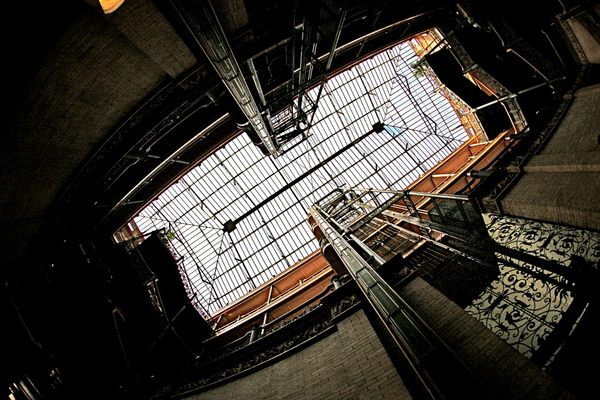Le Corbusier’s Special Measuring Tape Is Making a Comeback
The architect thought his unique measurement system was revolutionary, but no one really used it besides him.

In the summer of 1948, while visiting the 13th-century ruins of the Chaalis Abbey, just north of Paris, the architect Charles-Édouard Jeanneret “was struck by the fine proportions of the door (that of the transept, as I remember).” Jeanneret, better known as Le Corbusier, proceeded to reach into his pocket and take out a specially designed red-and-blue measuring tape to see whether the proportions were as perfect as he imagined. They were!
Le Corbusier used the same tape to measure Ancient Egyptian ruins, as well as historic buildings in Istanbul, İzmir, Athens, Lima, and beyond. He claimed that they, too, conformed to his measuring tape’s uniquely calculated proportions. But what was this magical measuring tape? And how and why did the architect design it in the first place?
Dubbed the “Modulor Rule,” Le Corbusier’s invention was the result of years of frustration with the metric system. According to the architect, the metric system was devoid of all human context, and hence incompatible with architectural needs. But because it was already deeply ingrained in the vocabulary of architects and engineers worldwide, it would be impractical to get rid of the metric system entirely. Instead, Le Corbusier hoped to inject some much-needed humanity into it.
“The French Revolution did away with the foot-and-inch system, with all its slow and complicated processes,” the architect wrote in his 1948 text The Modulor: A Harmonious Measure to the Human Scale Universally Applicable to Architecture and Mechanics. (This was the first of two whole books he dedicated to his new approach.) “The savants of the [1875 Metre] Convention adopted a concrete measure so devoid of personality and passion that it became an abstraction, a symbol: the metre, forty-millionth part of the meridian of the earth.”

In as much as Le Corbusier hated the metric system, he wasn’t fond of the Imperial system either, calling it “steadfast in its attachment to the human body, but atrociously difficult to handle.” In the increasingly globalized world of the 1940s, he felt the best way to deal with this problem would be to somehow fuse the two measurement systems into a single universal one.
For philosophical inspiration, Le Corbusier looked to music. “Music, like architecture, is time and space,” he wrote. “Music and architecture alike are a matter of measure.” Just as musical notation and the tempered scale served to standardize Western Classical music, so, too, would his Modulor system standardize architecture.
The Modulor system itself is a rather confusing combination of human proportions, the golden ratio, and the Fibonacci sequence. The math becomes fairly complicated, but the general concept is that a structure built for human habitation should start with the proportions of the humans themselves. Le Corbusier based his very first Modulor system on the measurements of what he perceived to be a typical “French height” of 1.75 meters or 5 feet 8 inches tall, but ultimately, he decided that, because this was to be an international system, the “ideal man” should instead measure a bit taller, at 6 feet or 1.83 meters tall. (As he wrote in The Modulor: “Have you never noticed that in English detective novels, the good-looking men, such as the policemen, are always six feet tall?”)
Both the symbol and basis of the Modulor method of measurement is a muscular, six-foot-tall man with a wasp-like waist and an arm stretched above his head. Le Corbusier’s Modulor Man was like an updated version of Da Vinci’s Vitruvian Man. “A man-with-arm-upraised provides, at the determining points of his occupation of space—foot, solar plexus, head, tips of fingers of the upraised arm—three intervals which give rise to a series of golden sections, called the Fibonacci series,” he wrote. “On the other hand, mathematics offers the simplest and also the most powerful variation of a value: the single unit, the double unit, and the three golden sections.”

These preliminary measurements—feet to waist, waist to top of the head, top of the head to tips of the fingers of the upraised arm—serve as the basis of measurement for the Modulor Rule. The ratios between these measurements are then used to determine the ideal proportions of buildings, furniture, and any and all other aspects of the human environment. The measuring tape itself breaks down these proportions, from the miniscule to the architectural, so that one could theoretically use the tape to measure the proportions of a variety of things, from a bannister to a building.
Le Corbusier clearly believed his Modulor system was revolutionary, and he had a habit of carrying the special measuring tape around in a film canister in his pocket when traveling. In The Modulor—a book that is in essence a self-congratulatory saga of how he came up with his idea—Le Corbusier recounts talking to Albert Einstein about the Modulor system, quoting the great mathematician as having said, “It is a scale of proportions which makes the bad difficult and the good easy.”
Although Le Corbusier thought the Modulor would change the way architects work all around the world, he was probably the only architect that ever used it, most notably in his Unité d’Habitation in Marseille, France. Constructed between 1947 and 1952, the Unité d’Habitation was a utopian project, a largely self-sufficient building complete with shopping mall, hotel, restaurant, school, and a rooftop running track and pool, together with 337 apartments, all enclosed within the same structure. This utopian function paired nicely with the utopian Modulor method, which Le Corbusier used for numerous aspects of the design, from the plan and elevation of the building to the balconies, interior measurements of each apartment, and even the built-in furniture, including the woodwork. In tribute, a Modulor Man is carved into the concrete of the building itself.
Ultimately, the Modulor method failed to take off outside of Le Corbusier’s own designs, yet the architecture community continues to be fascinated by its history. In 2000, when Princeton Architectural Press and Fondation Le Corbusier created a facsimile edition of the Modulor Rule (complete with metal canister), it sold out almost immediately. A second batch of reproductions will be available in September 2018.

















Follow us on Twitter to get the latest on the world's hidden wonders.
Like us on Facebook to get the latest on the world's hidden wonders.
Follow us on Twitter Like us on Facebook